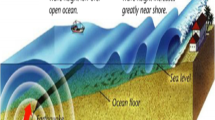Abstract
This paper discusses the applications of linear and nonlinear shallow water wave equations in practical tsunami simulations. We verify which hydrodynamic theory would be most appropriate for different ocean depths. The linear and nonlinear shallow water wave equations in describing tsunami wave propagation are compared for the China Sea. There is a critical zone between 400 and 500 m depth for employing linear and nonlinear models. Furthermore, the bottom frictional term exerts a noticeable influence on the propagation of the nonlinear waves in shallow water. We also apply different models based on these characteristics for forecasting potential seismogenic tsunamis along the Chinese coast. Our results indicate that tsunami waves can be modeled with linear theory with enough accuracy in South China Sea, but the nonlinear terms should not be neglected in the eastern China Sea region.







Similar content being viewed by others
References
Cho Y-S, Sohna D-H, Lee S (2007) Practical modified scheme of linear shallow-water equations for distant propagation of tsunamis. Ocean Eng V34:1769–1777
Comer RP (1984) Tsunami generation: a comparison of traditional and normal mode approaches. Geophys J Int 77(1):29–41
Geist EL (1998) Local tsunamis and earthquake source parameters. Adv Geophys 39:116–209
George DL, LeVeque RJ (2006) Finite volume methods and adaptive refinement for global tsunami propagation and indundation, Science of Tsunami Hazards, No. 5, V25, pp 319–328
Goto C, Ogawa Y, Shuto N, Imamura N (1997) Numerical method of tsunami simulation with the leap-frog scheme (IUGG/IOC Time Project), IOC manual, UNESCO, No. 35
Grilli S, Svendsen I, Subramanya R (1997) Breaking criterion and characteristics for solitary waves on slopes. J Waterway Port Coastal Ocean Eng 123(3):102–112
Gutenberg B, Richter CF (1949) Seismicity of the Earth and associated phenomena, Princeton University Press, Princeton
Kajiura K (1970) Tsunami source, energy and the directivity of wave radiation. Bull Earthquake Res Inst Tokyo Univ 48:835–869
Jensen A, Pedersem GK, Wood DJ (2003) An experimental study of wave run-up at a steep beach ATLE. J Fluid Mech 486:61–188
Novikova T, Wen K-L, Huang B-S (2000) Amplification of gravity and Rayleigh waves in a layered water–soil model. Earth Planets Space 52:579–586
Liu Y, Santos A, Wang SM, Shi Y, Liu H, Yuen DA (2007) Tsunami hazards from potential earthquakes along South China Coast. Phys Earth Planet Inter 163:233–245
Liu Y, Shi Y, Sevre EOD, Yuen DA, Xing H (2007) Probabilistic forecast of tsunami hazards along Chinese Coast. Visual Geosciences (Book), Springer, Heidelberg (submitted)
Liu Z et al (1988) South China Sea geology tectonic and continental margin extension (in Chinese), Science Press, Beijing
Okada Y (1985) Surface deformation due to shear and tensile faults in a half-space. Bull Seism Soc Am 75:1135–1154
Reiter L (1990) Earthquake hazard analysis: issues and insights. Columbia University Press, New York
Wang F, Zhang Z (2005) Earthquake tsunami record in Chinese ancient books. Chinese Earthquakes 21, V03:437–443
Wang J (1996) Global linear stability of the two-dimensional shallow-water equations: an application of the distributive theorem of roots for polynomials on the unit circle. Mon Wea Rev 124:1301–1310
Ward S (1982) On tsunami nucleation: an instantaneous modulated line source. Phys Earth Planet Int 27:273–285
Wells D, Coppersmith K (1994) New empirical relationships among magnitude, rupture length, rupture area, and surface displacement. Bull Seismol Soc Am 84:974–1002
Yamashita T, Sato R (1976) Correlation of tsunami and sub-oceanic Rayleigh wave amplitudes. J Phys Earth 24:397–416
Zang S, Ning J (2002) Interaction between Philippine Sea Place (PH) and Eurasia (EU) Plate and its influence on the movment eastern Asia. Chinese Journal of Geophysics, 45, V01:188–197
Acknowledgments
We would like to thank Professor Fumihiko Imamura for providing computational codes TUNAMI_N1 and TUNAMI_N2, and his kind guidance on tsunami numerical modeling. This research is supported by National Science Foundation of China (NSFC-40574021, 40728004) and the EAR program of the US National Science Foundation.
Author information
Authors and Affiliations
Corresponding author
Rights and permissions
About this article
Cite this article
Liu, Y., Shi, Y., Yuen, D.A. et al. Comparison of linear and nonlinear shallow wave water equations applied to tsunami waves over the China Sea. Acta Geotech. 4, 129–137 (2009). https://doi.org/10.1007/s11440-008-0073-0
Received:
Accepted:
Published:
Issue Date:
DOI: https://doi.org/10.1007/s11440-008-0073-0




